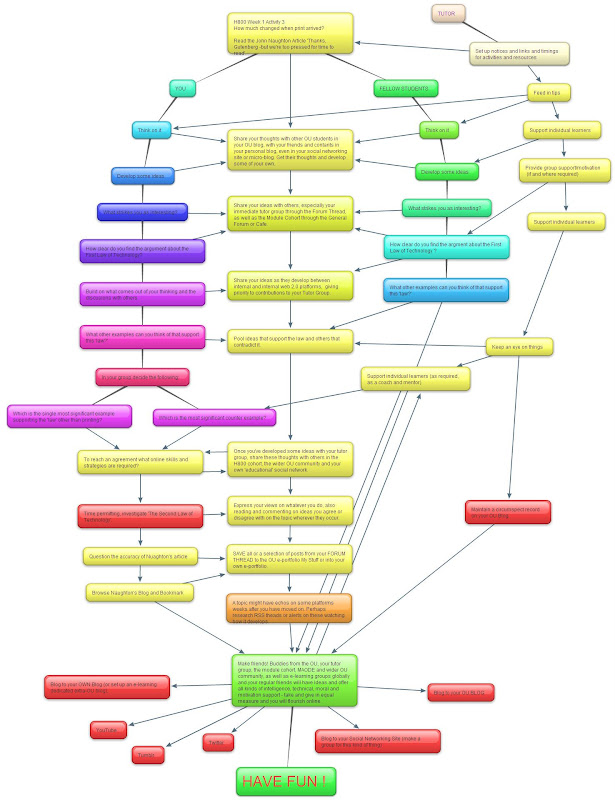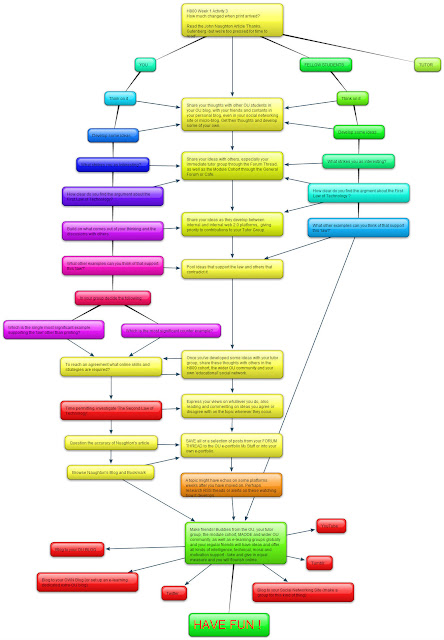As it is a bank holiday and the first in many years that I recall being sunny, I find I am getting online for an hour or two at dawn to do some stiudent work and write this. Then I walk the dog along the River Ouse or up on the South Downs and the day is mine/ours.
Painting the porch 
Then nodding off in the sun with a course book or two, a couple in print, a 2011 publication from John Seely Brown on the Kindle.
How, when and why blogs and threads work or fail is the topic of conversation.
I used to treat forums and assignments, optional or otherwise, as the weekly essay - something I had to do whether or not I engaged with others. I would also take part on a whim, responding to some entries, and happily letting the conversation drift off topic. Length was no object either. I lurked in other tutor forums too, making the time to follow how what ought ostensibly to be the same conversations could be very different indeed - some very active, some dead.
A year on I am more strategic.
I would like to be sharing the learning process, contributing to the conversations whether I can help or not, whether I am seeking answers or asking questions. The Cafe and General area serves a purpose to take 'over spill' though it functioned best in H808 where a moderator management the supplementary activities.
Gilly Salmon's 'E-moderating' has a good deal to say on this.
It is worth owning,. not simply to read cover to cover, but to have as a reference. I may not like the term 'e-moderator', but 'moderator' is, however diminishing or disparaging to a Dphil, the main function here. It could be carried out by a postgrad student, even an animated undergrad.
What matters is engagement.
Someone may need to act as the 'eyes & ears' for the group until it is established. Introductions have to be made, conversations started and moved along ... if anyone is rude, they should be quietly put in their place; if anyone is being like a door-mouse, they need support.
'The essential role of the e-moderator is promoting human interaction and communication through the modelling, conveying and building of knowledge and skills'. (Salmon, 2005:4)
There isn't a structure, no more than there is in a car or coffee bar.
The structure comes about from the people and activity in it. This is shaped entirely by the behaviour of the participants. 1) They have to turn up 2) Someone has to have something to say 3) Some of us need to be going around like a host, 'making polite conversation', 'networking', even introducing people. It IS a social gathering.
Tutor is a better term. It is valid.
Indeed the beauty of working online is that you can recreate the essence of an 'Oxbridge Tutorial', that privilege one-to-one, or one to two or three, that is the weekly essay read out and discussed.
Discussion is the key.
The tutor DOES NOT need to be a subject matter expert. See my interview with Oxford Senior Lecturer Dr Zbigniew Pelczynski.
Whilst the tutor cannot keep waving pixie dust over a group that simply does not gel they ought to try, especlally in the first weeks and especially with students new to this set up.
Why I participate in some forums and not others.
Often because someone else has started the ball rolling, and often. I will be the first if I have a need to get through the week's work and no one else has made a start. I may fret about covering all bases giving my response too much thought ... and therefore resulting in something overly long. Not easy to adhere to but I try to set parameters; 250 words typical, 500 words an absolute max after that think about offering it as an attachment.
It can be like chosing a restaurant!
You want to go where there's some buzz already, though not so much that you feel you will never be able to join in the conversation.
The reality is different.
This is an asynchronous beast. If I come in late I may read every post with care before I respond, which can result in a long response. People should feel just as comfortable simply answering the question, ignoring others at first .. or just reading the last couple of posts and responding to them.
It is tempting to respond to someone in a DIFFERENT tutor group if they say something strong; you're not supposed to do so! I might quote them in my own group. There have been times when lifting the thread of catalyst that got them going in another group will do the same in your own.
How my input is affected by the way the forum is structured.
At Harvard they use as system called 'Rotisserie' in some asynchronous threads/forums which, like playing pass the parcel (or pass the microphone) require people to take it in turns to say something. No harm there! No all the time, but for ice-breakers and specific, important threads it may work very well. Everyone has something worth saying, our differing perspectives are a vital part of the experience.
I'd like these threads to be presented very differently, as cards placed around a table. This sounds like a step towards a Virtual World. I just don't 'see' conversations as lists or 'toilet roll scrolls' from top to bottom, rather they should be in a circle at least, in a spiral at best.
It matters that activities have been designed that get people engaged without the need for a tutor all the time.
'Structured, paced and carefully constructed e-tivities reduce the amount of e-moderator time, and impact directly on satisfactory learning outcomes, adding value to the investment in learning technologies'. (Salmon, 2002a)
Do I behave differently in face-to-face tutorials?
I'm the student who says they understand but the tutor will see that on my face it says 'I still haven't a clue'. I will stop asking questions. Here I will ask more often, then start asking elsewhere, within h800, even beyond the Masters in Open and Distance Education. I'm still asking people how to visualise the learning process in threads, forums and blogs away from here.
Face-to-face people don't need to put up their hand to ask a question, you can read the person, you can tell if they are anxious to join in at some point. You don't need 'rotisserie' as people do take it in turns. Someone will act as the chair, even is there isn't one nominated. Think of us like the Village Elders taking it in turn to reflect on an issue.
Seeing that someone else has already made an effort to answer the week's questions I decide I can and should make the effort to do the same. It is easier to reply to the questions and ONE response than the question and 16 responses! i.e. I like to be second, or third to comment, rather than first or last. No good if everyone is hanging back. Perhaps between us we should nominate someone to go first each week!!!
'Online learning calls for the training and development of new kinds of online teachers - to carry out roles not yet widely understood'. (Salmon. 2005:10)
REFERENCE
Salmon, G (2005) E-moderating. The Key to teaching and learning online.
AND FINALLY, I relate to this, also from Gilly Salmon's book:
'Consider this medium as like talking with your fingers - half-way between spoken conversation and written discourse.' (Hawkridge, Morgan and Jeffs, 1997, quotes in Salmon 2005)






